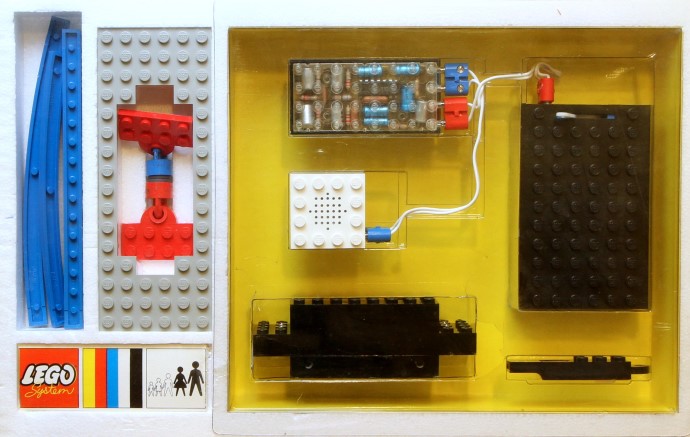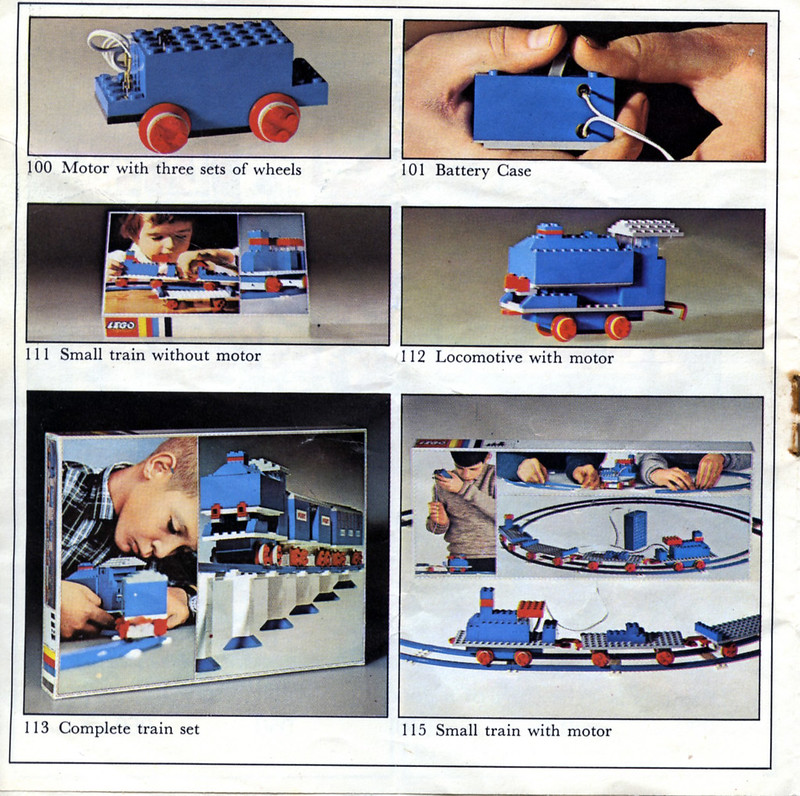Throwback Thursday: 1968
Posted by Huw,
To celebrate the launch of 21306 The Beatles Yellow Submarine next week we are going to be publishing a series of articles about the LEGO and the 1960s: the sets available, the history of the company and milestones in the decade, 1960s influences on sets released subsequently, and so on.
To kick-off I am going to take a flick through the 1968 UK catalogue to find out what was on toy shop shelves the year that Yellow Submarine was released.
Basic sets
The mainstay of the LEGO assortment in the 1960s was the basic set. Dozens were produced during the decade and just to confuse things numbers were often re-used. Many of those pictured below were released in 1965 so had been on the shelves for four years.
As you can see they appear to be a random assortment of mostly red and white pieces, with the odd blue and yellow ones thrown in for good measure. I do not believe any of them came with instructions so you were left to your own devices if you wanted to build what was shown on the box.
A new range of Basic sets had been released in mainland Europe in '68 according to the German catalogue but did not make it to the UK until the Autumn of 1969, as seen in the UK 1969 catalogue
Notice 'Lego' in improper case...
Planpacks
'Planpacks' were a relatively new innovation. According to page 5 of the catalogue "Planpacks contain the right number of of bricks for building a special model such as a bus or a garage...". Sound rather familiar, don't they!
This year a range of 6-wide vehicles was introduced which as a kid I thought were absolutely fantastic. They all had self-centering steering which was achieved by a special plate that had a 'springy bit', for want of a better term, that mated with a pair of small knobs on a steering column which could be rotated using the LEGO brick on the top of the cab. The doors were pretty special, too. Transparent with a painted lower section, if I remember correctly.
Trains
Trains were an important aspect of the second half of the 1960s LEGO range. One quarter of the pages in this catalogue are devoted to them.
Those on this page were part of the initial assortment of train sets released in 1966 and are all very basic.
However, 119 Super Train Set, released this year, is far more realistic, with working signals, level crossing and magnetic couplings. In fact, more sophisticated in many ways to the 9V trains of the 1990s.
That is certainly the case with 118 Electronic Train, also released in 1968, which comes with a small microphone unit which responds to a whistle to start and stop to the train!
Imagine opening this box up as a kid and seeing this inside! Sadly, I did not have one so I have to imagine too...

Parts packs
Along with Basic sets, parts packs were an integral part of the assortment, with literally dozens available. Packs with coloured squares in the corner were available in multiple colours e.g. 480 Slopes and Slopes Double 2 x 4, Red and 480 Slopes and Sloped Double 2 x 4, Blue
You can find a PDF of the entire UK 1968 catalogue, and hundreds of others, in our library.
Regional variations
In the 1960s, the LEGO sold in the USA and Canada was produced under license by Samsonite and as a result, a completely different range of sets was available. There is an excellent repository of old Samsonite paperwork at BrickFetish.com, including a 1968 dealer's catalogue.
Even within Europe there was a lot of variation, with the UK seemingly seeing a much smaller assortment than mainland Europe, as evidenced by comparing the above with this 1968 German catalogue.
So, when your parents went off to the cinema/theater/theatre to watch Yellow Submarine, 2001: A Space Odyssey, The Thomas Crown Affair, Planet of the Apes or some other film released in 1968, what were you left at home to play with?
42 likes






14 comments on this article
I want all that automatic things!
Now you are talking business!
There is WAY too little about real classic LEGO on Brickset.
Is that truss bridge in the first image made out of curved rail pieces? If so, very ingenious!
You know, I'm really staggered that they were doing that whistle-controlled electronic train in 1968 - not because it's technically a massive leap based on electronics at the time, but because I remember when the Nintendo DS came out in 2004, and were all going, "WHOA, you can blow on or speak into the microphone to control action on-screen!" - now, with a bit of game coding, that's the same technology, and it seemed so innovative then, yet Lego had got there a long time before... it's also just so perfect that it's a whistle, so a kid can play at being the station-master.
For some reason that also reminds me of how the Temple of Airjitzu has a shadow puppet theatre: on the face of it, they're two very different gimmicks, but they both combine simplicity with that quality of being the perfect use of technology used in just the right set, which to me is very characteristic of TLG at their best.
And of course, it's just lovely to gaze at all those Basic sets and Plan packs - that mechanism you mention explains some of the oldest parts that we have...
Thanks for a fantastic post, Huw: really looking forward to the rest of the series! :)
Wow sound control Lego in the 60s; man I was impressed at 8 (1982) when I received 8050 and my sets worked and was not far off from being remote control.
I'm surprised Lego hasn't brought back the sound bricks since they have had the light up brick for several years
Just a small thing, there is a typo: 'When youR parents'.
Nicely done, Huw! Thanks, and keep these classic LEGO articles coming!
Excellent article, have missed these the last few months!
Thanks for that article, Huw! Espesh for the news that the vehicle steering plate had a little springy tongue. By the time the remnants of http://brickset.com/sets/377-2/Crane-and-Float-Truck passed through my brother's clumsy hands into mine, that slender (0.5mm thick?) piece had long since snapped off, leaving a frustratingly free-spinning axle brick.
^ Yes, it was rather fragile, wasn't it!
When did the large baseplate change from 50x50 to 48x48?
I wish they still did "Parts Packs". I know we have Pick-a-Brick now, but wouldn't it be nice to just buy an off-the-shelf pack? "Vegetation Pack" with a mixture of trees, bushes and flowers. "Street Furnishings Pack" with lamps, rubbish bins, road signs. "Animals Pack" with ... errrrmmm ... animals.
In other words, introduce specialist packs to fit in with these : http://brickset.com/sets/theme-Bricks-and-More
^^ 1980 according to Bricklink:
http://www.bricklink.com/v2/catalog/catalogitem.page?S=843-1
I still have one of the 50x50 baseplates. 1968 is just a little too early for me but I remember playing with the blue trains in my neighbours' house in the 1970s.
I would love to have 335 sitting beside 3221 on my shelf!
My first Lego set was 722, a bit later than this era, but still you can see a lot of influence. 722 is actually a great set--very versatile, and lots of detailed but not-too-specialized parts.